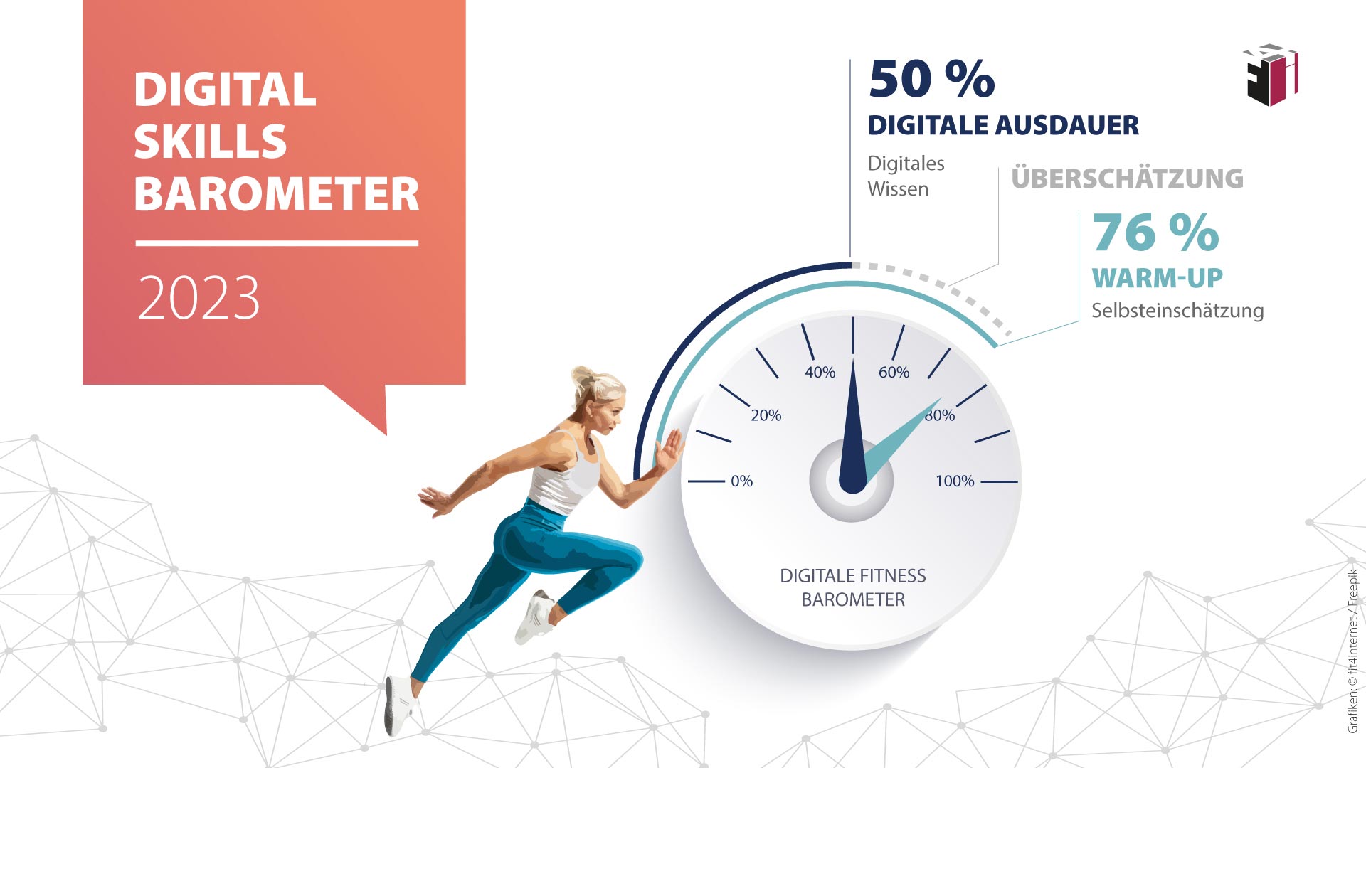Zahlen, Daten, Fakten
Wie es um die "digitale Fitness" in Österreich bestellt ist, wird in Österreich seit 2022 mit dem Digital Skills Barometer auf einzigartige Weise ermittelt.
Beim Digital Skills Barometer handelt es sich um die erste repräsentative Erhebung, mit der digitale Kompetenzen in Österreich basierend auf dem Kompetenzmodell DigComp AT erfasst werden. Dabei werden Selbsteinschätzung, digitales Wissen, Technologieaffinität und Fragen zu digitalen Schwerpunktthemen kombiniert, um die wichtigsten Hebel in der digitalen Kompetenzsteigerung zu erfassen. Das Ergebnis des Digital Skills Barometer ist ein detailliertes Lagebild über den Digitalisierungsgrad der österreichischen Bevölkerung und bildet die Basis für die nächsten Schritte zum Kompetenzaufbau.
Die erste Erhebung wurde in den Monaten April und Mai 2022 mit einer nach Geschlecht, Alter und Bundesland geschichteten Stichprobe mit knapp 4.000 in Österreich lebenden Personen durchgeführt. Die Erhebung des "Digital Skills Barometer 2023" wurde von Mai bis Juli mit knapp 3.700 Personen durchgeführt, und die neuesten Ergebnisse wurden im November 2023 veröffentlicht. Der umfassende Bericht des Digital Skills Barometer 2023/2024 umfasst drei inhaltliche Teile, die sequentiell publiziert und hier veröffentlicht werden. Im Herbst 2024 wurde auf Basis einer zusätzlichen Erhebung mit Fokus auf K.I. eine Sonderedition des Digital Skills Barometer zu Künstlicher Intelligenz veröffentlicht. Ende 2025 erfolgte mit dem Vienna Digital Skills Insight – einer Sondererhebung im Rahmen des Digital Skills Barometer 2025/2026 zu Digitaler FLEXILIENZ – die Veröffentlichung der Ergebnisse für Wiener Erwerbstätige im Alter von 16 bis 69 Jahren..
- NEU: Vienna Digital Skills Insight mit Einblicken in ausgewählte Ergebnisse der digitalen Flexibilität, Resilienz und Kompetenz im Kontext von Technologien und Anwendungen (Schwerpunkt: Cloud, Cyber, Data und Künstliche Intelligenz).
- Mission 20:24 mit Ableitungen und Empfehlungen für Entscheidungsträger*innen zum Digitalen Kompetenzaufbau in Österreich. Abgeleitet aus dem Digital Skills Barometer 2023/2024 und der Sonderedition KI-Kompetenzen.
- DSB-Sonderedition Künstliche Intelligenz: Sind die Österreicher*innen fit für K.I.? Erfahren Sie in der Sonderedition des Digital Skills Barometer 2024 – KI-Kompetenzen alles über Wissen, Nutzung, Herausforderungen, Ängste und Chancen im Umgang mit K.I.
- Teil 1 bis 4 des Digital Skills Barometer 2023/2024 (DSB Report) mit allgemeinen Ergebnissen zur digitalen Fitness der österreichischen Bevölkerung, zu den Grundlagen der Digitalisierung, Bundesländern, Geschlechtern und vieles mehr ist darin zu finden.
- Hier finden Sie eine Sammlung mit Ergebnissen zum Wissen über die wichtigsten Technologiebegriffe und Erklärungen zu diesen Begriffen.
- Die Ergebnisse der ersten Studie (2022) können Sie hier herunterladen (PDF).
Highlights des Digital Skills Barometer 2023
Österreicherinnen und Österreicher überschätzen sich weiterhin. Die "Digitale Ausdauer" (das Wissen) der Österreicherinnen und Österreicher liegt bei 50 Punkten, während das "Digitale Warm-Up" (die Selbsteinschätzung) bei 76 Punkten liegt.
Problemlösen, Innovation und Weiterlernen sind Schwachstellen: Im Kompetenzbereich 5 existiert am wenigsten Wissen und am meisten Selbstüberschätzung.
Knowhow-Zuwachs im Bereich Sicherheit: Die Wissenslücke im Bereich 4 („Sicherheit und nachhaltige Ressourcennutzung“) hat sich gegenüber 2022 deutlich reduziert, und es kam zu positiven Kompetenzverschiebungen.
Ein Gender-Gap besteht noch immer. 60% der Frauen sind "digitale Nachzügler". Dabei gibt es Zusammenhänge zu ihrer beruflichen Situation und ihren Interessen.
Partner von fit4internet im Projekt 2023
Eviden Austria (2023), ETC, Industriellenvereinigung Österreich, Wirtschaftskammer Österreich, Siemens, Spar Österreich, Berufsförderungsinstitut Österreich, Wirtschaftsförderungsinstitut Österreich
Highlights des Digital Skills Barometer 2022
Digitale Fitness wird falsch eingeschätzt. Die Ergebnisse zeigen, dass Selbsteinschätzungsfragen oder Fragen nach Nutzungsgewohnheiten nicht ausreichen, um die tatsächlichen digitalen Kompetenzen der Österreicherinnen und Österreicher zu ermitteln. In der Regel wird die eigene digitale Fitness überschätzt.
Übung ist Voraussetzung für digitale Leistungsfähigkeit. Wie im Sport reicht es auch in der digitalen Welt nicht aus, sich nur wenige Male mit digitalen Entwicklungen und Anwendungen zu beschäftigen. Um eine solide Kondition aufzubauen und fit zu bleiben, braucht es laufende Praxis.
Ein hoher Bildungsabschluss macht digital fit. Formale Bildung korreliert mit digitaler Kompetenz. Je höher der formale Bildungsabschluss, desto höher ist im Durchschnitt auch die digitale Fitness und desto realistischer die Selbsteinschätzung der eigenen digitalen Kompetenzen. Formal höher gebildete Personen erkennen ihre Wissenslücken leichter und bilden sich häufiger zu digitalen Themen weiter.
Der Gender-Gap benötigt Aufmerksamkeit. Frauen schätzen nicht nur ihre digitalen Kompetenzen geringer ein als Männer, sondern sie erzielen im Vergleich zu Männern auch einen geringeren Fitnessgrad. Zugleich ist die Home-Office-Ausstattung durch Arbeitgeber für Frauen schlechter als für Männer. Viele spricht dafür, die digitale Kompetenz von Frauen durch Bewusstseinsbildung, Konditionstraining und Ausstattung zu fördern.
Österreicherinnen und Österreicher lernen informell. Digitale Kompetenzen zählen gemäß der Europäischen Kommission zu den acht Schlüsselkompetenzen für „Lebenslanges Lernen“, aber gerade einmal 10,4% der Bevölkerung zwischen 15 und 74 Jahren nehmen im Jahresdurchschnitt an entsprechenden Kursen oder Schulungen teil. Die Lernrealitäten für die digitale Welt gestalten sich eher informell: Der Aufbau der digitalen Skills findet zu knapp 70% über individuelles Ausprobieren oder Internet-Plattformen und -Foren statt.
Partner von fit4internet im Projekt 2022
Accenture, Bundesministerium für Finanzen, ETC, Industriellenvereinigung Österreich, Wirtschaftskammer Österreich


